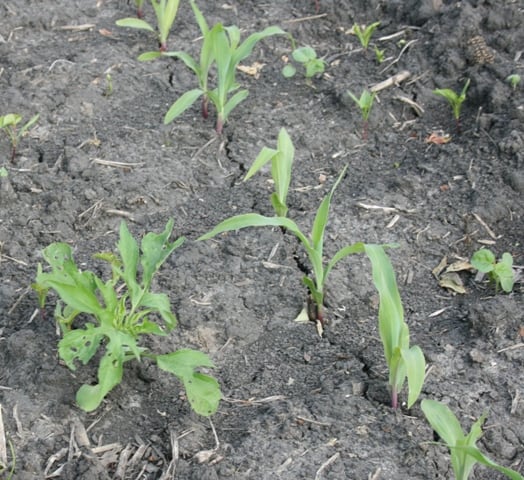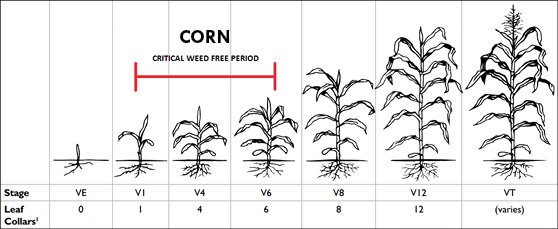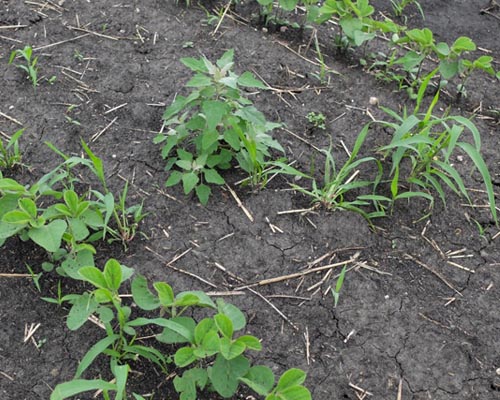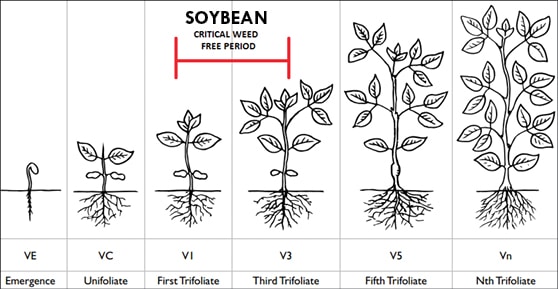When is the critical weed-free period?
It is the critical point in time during the growing season when weeds cause the largest yield loss.
Weed-free period in corn
In corn this period occurs from V1 to V6 (1 to 6 leaf collars). Some sources will mention that it even begins at the VE stage (emergence). During this time the corn crop needs to stay clean. Weeds will affect yield if control is not provided.
Graph source: OMAFRA Agronomy Guide for field crops.
Weed-free period in soybeans
For soybeans the period is the V1-V3 (1 to 3 trifoliates). In Ontario (assuming a normal spring), the V3 stage is roughly 20 days after crop emergence. If you can control weeds during this time, losses should be assumed to be under 5%.
Graph source: OMAFRA Agronomy Guide for field crops.
Why are these periods important?
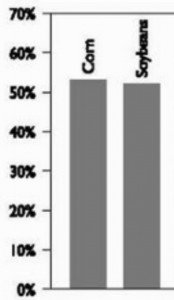 It is critical to stay weed-free during these periods if a grower wants to maximize yield potential. Corn and soybeans on average can have a yield loss of up to ~50-60% during this time if control is not provided; and even higher depending on the weed.
It is critical to stay weed-free during these periods if a grower wants to maximize yield potential. Corn and soybeans on average can have a yield loss of up to ~50-60% during this time if control is not provided; and even higher depending on the weed.
There are times pre-plant/emerge residual herbicides do not work as originally hoped or are not used at all. Growers often put faith in residual products and then do not scout enough to determine if acceptable control was achieved.
In many cases, it may be confusing as to when the best time to spray a herbicide is in order to be the most effective, and to keep their full yield potential. These periods help give a guide as to how long you need that residual product to work. It also helps to determine when a post-emerge herbicide is necessary to allow proper plant development.
To reduce yield loss, the critical weed-free period is key to knowing the right time to apply herbicides.
How can knowing these periods help?
By understanding these periods, it allows a grower to be proactive on weeds and to make better choices on the timing of a herbicide application. By starting and staying clean, growers can add to their bottom line and increase yield. Growers struggle at times with applying a late application of herbicide. Was it really necessary? Did I waste input costs? Understanding the critical weed-free period can help you reduce later applications of herbicides and reduce these tough decisions.
How weed competition works:
The corn and soybean plants can detect when weeds are present. The crops goal is to gather as much resources as possible to complete its reproduction cycle. Weeds do the same and directly compete for resources such as light, moisture, and nutrients. Weeds can attract insect pests and be an alternative host for disease. Broadleaf weeds are generally more competitive than grasses and yield losses that occur will be greater.
Weeds emerging after the critical periods generally have lower seed production and are not typically an issue. Many growers are concerned if they spray too early and weeds begin to grow after these periods, that yield will be affected. In most cases it will not affect final yield.
There are situations where a particular weed growing in the crop at harvest may reduce harvesting efficiency and reduce the overall quality of the crop. This is why it is important to identify what types of weeds are on your farm. Understanding whether they are perennials or annuals, their growth patterns, and their concern for elevators and end users of the crop will allow the grower to make better decisions as to which herbicide will be most effective for the individual farm weed spectrum.
Did you know...
90% of corn acreage in Ontario is treated with some sort of post emerge herbicide.
Weed control tactics:
- Time Management:
Know your acres and your fields, your crop stage, watch the weather and make a plan. - Crop Rotations:
Rotating crops will provide varying levels of crop competition on weeds and allows you to use multiple groups of herbicides. You can then specifically target problem weeds when you have the most effective herbicide option. - Cultivation:
Working soil can be an effective way to reduce weed pressure. It can also be used to trigger weed emergence to target as many as possible when the grower chooses. - Herbicide Group Rotation:
Keep rotating your herbicide mode of action. It will greatly reduce the risk of resistance developing. - Cover Crops when Possible:
Cover Crops allow more ground cover and keep weed pressure at a minimum. - Row Width/Population:
Having rows closer together and higher populations will increase the crops competition with weeds.

